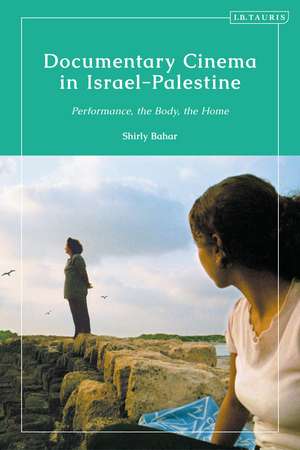Documentary Cinema in Israel-Palestine: Performance, the Body, the Home
Autor Dr Shirly Baharen Limba Engleză Hardback – 28 iul 2021
| Toate formatele și edițiile | Preț | Express |
|---|---|---|
| Paperback (1) | 191.67 lei 6-8 săpt. | |
| Bloomsbury Publishing – 25 ian 2023 | 191.67 lei 6-8 săpt. | |
| Hardback (1) | 569.29 lei 6-8 săpt. | |
| Bloomsbury Publishing – 28 iul 2021 | 569.29 lei 6-8 săpt. |
Preț: 569.29 lei
Preț vechi: 816.25 lei
-30% Nou
Puncte Express: 854
Preț estimativ în valută:
108.93€ • 118.70$ • 91.79£
108.93€ • 118.70$ • 91.79£
Carte tipărită la comandă
Livrare economică 23 aprilie-07 mai
Preluare comenzi: 021 569.72.76
Specificații
ISBN-13: 9781838606824
ISBN-10: 1838606823
Pagini: 248
Ilustrații: 43 bw illus.
Dimensiuni: 156 x 234 x 22 mm
Greutate: 0.53 kg
Editura: Bloomsbury Publishing
Colecția I.B.Tauris
Locul publicării:London, United Kingdom
ISBN-10: 1838606823
Pagini: 248
Ilustrații: 43 bw illus.
Dimensiuni: 156 x 234 x 22 mm
Greutate: 0.53 kg
Editura: Bloomsbury Publishing
Colecția I.B.Tauris
Locul publicării:London, United Kingdom
Caracteristici
The joint study of the Palestinian and Mizrahim experience shifts the conventional paradigm of conflict in studying Israel/Palestine to one of colonial structures and racial oppression
Notă biografică
Shirly Bahar teaches in the School of Visual Arts at Columbia University in New York, USA, and is the co-director of the Tzedek Lab network. She received her PhD from New York University's Hebrew and Judaic Studies Department.
Cuprins
Introduction Part I: The Body1. Jenin: Living with Martyrdom in Mohammad Bakri's Jenin Jenin and Since You Left, and Juliano Mer-Hamis' Arna's Children 2. Heads Held High: Mizrahim's Coming of Age and Activism in David Belhassen and Asher Hamies' The Ringworm Children,David Benchetrit's Kaddim Wind: A Moroccan Chronicle, and Nissim Mosek's Have You Heard of the Black Panthers? Part II: Home3. Speaking Out About the Places of Palestine in Israel in Rachel Leah Jones' 500 Dunam on the Moon, Michel Khleifi and Eyal Sivan's Route 181, and Ibtisaam Maraana's Paradise Lost 4. A Mother Tongue, A Daughter's Voice: Mizrahi Women's Homecoming to the Arabic Language in Effi Banai's Longing and Israela Shaer-Meoded's Queen Khantarisha Concluding Notes: Looking Towards Mizrahi Solidarity with the Palestinian Struggle Bibliography
Recenzii
Documentary Cinema in Israel-Palestine is a major contribution to understanding 21st-century transnational film history. Looking at key documentary films by Arab and Mizrahi filmmakers living within the contested borders of Israel-Palestine, Shirly Bahar develops an argument for the vital place of documentary within contemporary politics and identities. Deeply attuned to the process by which documentary invokes and provokes intimacies across various boundaries-filmmaker, subject, audience; spaces and places; languages; among them-Bahar makes a case for documentary as a philosophical, as much as visual and aural, form. Through close readings of several crucial films from the first decade of this century, Bahar expounds on the ways in which documentary, as witness to damaged bodies in devastated places, makes visible the ravages state violence wreaks on truth, language and landscape. Violence against Israeli and Palestinian Jews and Arabs (and Bahar makes clear that the simplistic dichotomy Israeli Jews/Palestinian Arabs is part of the erasure of history performed on these bodies and places since 1948) finds its way into the films by Arab and Mizrahi filmmakers through lenses focused on reenacting pain and retelling memory. Bahar's insights reveal how occupation and war, on a large scale, and naming, property, even home restoration, on a more personal level, are grasped within the varieties of encounters-at once awkward, hostile and intimate-made possible by documentary cinema. In this profound study, we see how documentary and its critics mediate a uniquely performative and affective politics in Israel-Palestine, but also elsewhere and everywhere.
